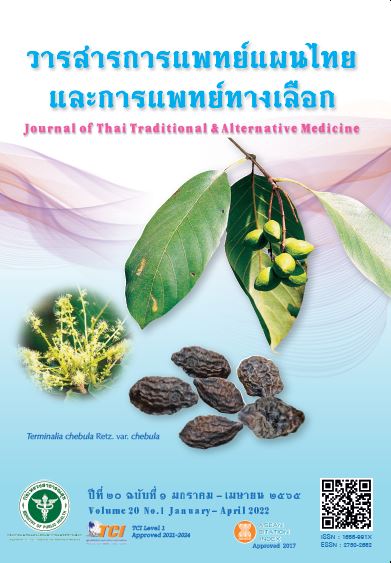Efficacy of Prasanamnom Recipe in Increasing Breast Milk Volume in Postpartum Mothers
Main Article Content
Abstract
Breastfeeding is the starting point for promoting children's health to prevent various diseases in infants. Prasanamnom recipe was introduced in Pathomjinda, a Thai traditional medicine scripture, for its lactation-stimulating property. However, there has been no study on the efficacy of Prasanamnom recipe in improving lactation. This was a quasi-experimental study that aimed to explore the efficacy of Prasanamnom recipe in increasing milk volume in postpartum mothers. Participants were 24 postpartum women (mean age, 29 years) who had normal delivery and gave breastfeeding at Phromphiram Hospital and were divided into two groups. Group 1 received Prasanamnom recipe, 100 mL orally, three times a day, before meals, and group 2 received standard care. The amounts of milk obtained with an automatic breast pump were measured after using a 15-minute pumping session on the 2nd, 3rd, 7th and 14th days after birth; and the increases in milk volumes within the groups were compared using paired t-test statistics. A comparison between groups with unpaired t-test statistic found that both groups after treatment had the same increase in milk volume. In the group receiving Prasanamnom recipe, there was a significant increase in milk volume from the 3rd postpartum day, and when compared between groups, the amount of milk volume 14 days postpartum was significantly higher in the experimental group than in the control group (p < 0.001). In the Prasanamnom recipe group, one postpartum mother had nausea after taking the recipe. In summary, Prasanamnom recipe can increase breast milk volume in mothers after childbirth. More studies should be done on the mechanism of action of the Prasanamnom recipe formulation. Clinical studies on the efficacy and safety of this formulation should be continued.
Article Details

This work is licensed under a Creative Commons Attribution-NonCommercial-NoDerivatives 4.0 International License.
References
Foundation of the Breastfeeding Center of Thailand. Breastfeeding promotion program [Internet]. [cited 2017 Jul 11]; Available from: http://www.thaibreastfeeding.org/page.
php?id=266. (in Thai)
Pitipong S., Kwankhao P. Food and herb stimulate milk [Internet]. [cited 2017 Jul 11]; Available from: https://www.doctor.or.th/article/detail/5798. (in Thai)
Division of Healing Arts Department of Health Service Support. Textbook of traditional medicine Thai Medicine Branch. Volumes 1-3. 1st ed. Bangkok: printing house, Thai Phum Publishing Co., Ltd.; 2006. (in Thai)
Meepradit K. Effect of postpatum herbal of Kab Choeng Hospital, Surin Province (thesis). Nakhon Pathom: Silpakon University; 2011. (in Thai)
Suthiphan N. Herb nourish milk [Internet]. [cited 2017 Jul 11]; Available from: http://www.phargarden.com/attachments/article-20210903100101.pdf (in Thai)
Kwankhao P., Pitiporn S. Food and herb for breast milk. The 2nd National Breastfeeding Conference; 6-8 Aug 2013; Miracle Grand Hotel Convention. Bangkok: 2008. p. 56-67. (in Thai)
Srifa U. The effect of breast milk quantity and the successfulness of breastfeeding in Koh Samui Hospital [Internet]. [cited 2020 Dec 15]; Available from: https://so03.tci-thaijo.org/index.php/JMND/article/view/248275/167138 (in Thai)


